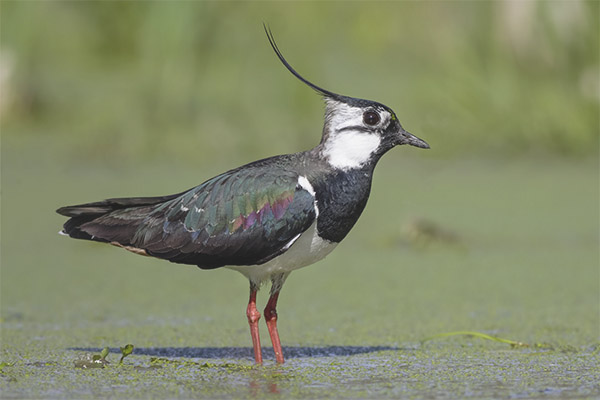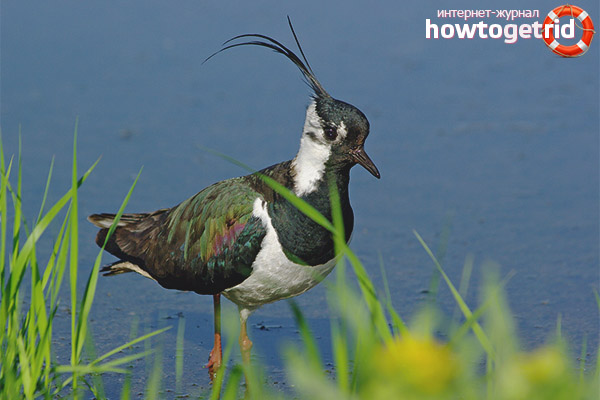The content of the article
Such a bird as a lapwick, familiar to most of the ordinary people called the Pigalitsa, at the expense of its small size is similar to the species belonging to the groups of passerines and pigeons. The average weight of a chibis does not exceed 250 g. Often, many people confuse it with siskin, however, these are two completely different species.
The characteristic features of the appearance of this bird include black tuft, located in the back of the head, and expressive eyes. The feathering of the lapwing is multicolored: on the neck and chest is black, on the wings and back is brown-green, the lower part of the body is white. The tail of the lapwing is long, a bit like a rooster, the legs are long red. The bird has such an original color of plumage only during the mating season, but at the usual time the dressing of a lapwing is not so attractive, mainly the feather is of a dirty white color.
The lapwing is one of the first birds returning from the hibernation to the main nesting site, which is why they were popularly called the forerunner of spring. The overcurrent of individuals of this species begins with the onset of heat (May-July), this period in the life of birds is very picturesque, the males in order to attract individuals of the opposite sex perform intricate shapes in the air, accompanied by a characteristic sniffing whistling.
Habitat
A few decades ago, the marshland was a nesting site for the tusk-tree, but as the marshes dried up and the arable land expanded, the birds were adapted to new living conditions in their natural environment, and live in fields and meadows,in close proximity to which are located reservoirs.
The nesting area of the species covers almost the whole of Europe, with the exception of the extreme northeast and Greece. Chibis populations, which have chosen to nest the region with rather severe winters, migrate south immediately after breeding. These birds are the very first to arrive to the main habitats after wintering, the preferred habitat area is the area near the water bodies, since most insects that live for the Siberian fishes are found near them. Quite often, nesting places fly in flocks with other birds: starlings and plovers.
Power Features

The basic ration of this species of birds is mainly composed of various small invertebrates, insects and their larvae. Note that lapwings are perfectly adapted to life near a person, while the latter does not prevent them from existing side by side. In fact, the lapwing is an assistant for humans, since it is engaged in the destruction of harmful insects in places of crops. However, the population of this species has declined significantly in recent years, the reason for this is lapwings.
Lifestyle
Restless pigtails refers to migratory species of birds. Those representatives of the species that choose the northern region of their habitat for nesting, migrate very early in the winter to the edges with a mild and warm climate. The bird returns to the nesting place immediately with the onset of the first heat (beginning of March).
For life, the lapwick chooses places characterized by low grass vegetation (river floodplains, the marshy coastal zone of small bodies of water, run-down ponds). In addition to feeding on insects and invertebrates, it can also eat some berries and plant seeds.
Closer to the beginning of summer, the birds gather in small flocks and begin to wander from place to place in search of a territory rich in fodder. At the same time, such a nomadic way of life is always carried out in one direction - towards the places of seasonal migration.
Breeding
The breeding season of lapwings begins with the onset of spring, when exactly this will be - at the beginning of the season or in the middle, directly depends on weather conditions and the availability of food. During mating games, the male begins to fly around the female Pigalitsa, making sounds that attract the attention of the opposite sex.
Observing from the side of the mating game of the chibis, anyone can note that the process of grooming the bird of the female of the pigtail looks very cute and even a bit comical. This is explained by the fact that the male, in order to attract the attention of the female, uses a variety of methods and, accordingly, achieves the goal.
Related species
Such a species of bird as a lapwing includes 24 species of birds of this family, which can be found on almost all continents (the exception is North America).A characteristic feature of this species are fairly wide wings with rounding, short beak, long legs and contrasting plumage in its color.
Interesting fact! In the event that the young are in danger from predators, the flock of birds unites to repel the enemy and protect their offspring.
Video: lapwing (Vanellus vanellus)












To send